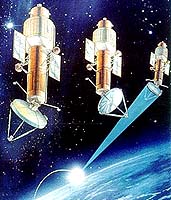Anybody want to bet we took it out before it could leave country?
So much for top-secret. It looks like POP-SECRET!


Posted on 05/07/2004 7:15:07 AM PDT by TigerLikesRooster
/begin my translation
Ryongchon Explosion Occurred While Transporting Military Cargo?
Sankei Shimbun, a Japanese Daily, reported on 7th (of May, 2004), "In Ryongchon Blast, Syrian engineers were killed and wounded. A wagon carrying a large cargo had a particularly heavy damage, revealed on 6th (of May, 2004) by a military news source who has great expertise on Korean matters." According to the source, "the content of the cargo is unknown. However, after the accident, N. Korean military personnels in protective suits arrived at the scene, and recovered the remains of the destroyed wagon. We strongly suspect that the accident occurred while transporting a top-secret cargo between N. Korea and Syria."
The paper went on to say, citing the source, "Passengers in the wagon were engineers dispatched from Syria's Scientific Investigation and Research Center(CERS). CERS's goal is promoting science and technology. It is also suspected of a major involvement in the Syria's development of WMD's."
It also reported, "Engineers were in a separate compartment in a wagon from the cargo compartment. It is not clear whether the cargo was the primary source of the explosion or the secondary source after explosion from other wagons. However, it is true that this wagon had the most extensive damage. Close to 10 personnels of both Syrians and N. Koreans were either killed or wounded."
Syrian casualties went home via a Syrian transport plane on May 1st, which was there to pick up the cargo. All personnels involved in the transport (of Syrians), both Syrians and N. Koreans, were again wearing protective suits.
The paper further added, "The behaviors of N. Korea and Syria showed that this cargo is of utmost secret nature, which they never want to disclose. Countries like America suspect that N. Korea and Syria are cooperating the development of Syrian Scud D missiles or chemical weapons."
/end my translation
Some places you have bedrock close to the surface and other places you don't. Where I live you could go 200 feet with no bedrock.
I have a question. If EO really went off, is it possible to take air sample after the explosion far away from the site, and find out it was the substance involved?
Anybody want to bet we took it out before it could leave country?
So much for top-secret. It looks like POP-SECRET!


First see reply #199.
I think I see where you're going with this. You're envisioning a warhead (or similar) that acts like a bunker buster. Here are the problems that I see with that idea.
First, true bunker busters are built around a very strong and very rigid body, so as to survive the plunge through 50 to 100 feet of rock and earth.
Second, contrary to popular conception, bunker busters don't make all that spectacular a crater. They don't need to, there function was to destroy a bunker 100 feet down, not blow everything above it to kingdom come.
Third, the most difficult part of making a bunker buster is the fusing mechanism. You need fusing components that can (reliably) survive the tremendous impact force of striking the ground and burrowing 100 feet down, before detonating the bomb at the proper place.
Fourth, in order for a bunker buster to reach the depths I've indicated, takes a very large mass, traveling at very high speeds, before it strikes the ground.
There is no missile component that I can think that would have the strength, the rigidity, the fusing , the necessary quantity of explosives, the mass, nor the speed to accomplish what we've seen in the photos.
Moreover, if a bunker buster type explosion was the cause of the disaster, then how do we account for the massive damage also done to such a large surrounding area? Even if a real bunker buster bomb had been used, their would have been relatively little peripheral damage to the surrounding town.
--Boot Hill
--Boot Hill
Thanks for your informed answer. It was my uninformed guesswork.:) I suppose that enough explosive power could create the crater of that width and depth.
As to whether there would be any unexploded EO thrown up in the air at the time of the explosion, I would be surprised if there weren't any.
But your question is more of a chemistry question than an explosives question, because EO is so reactive a compound, that by the time you took a sample downwind of the event and hours later, that you're most likely only going to find the breakdown products of EO, rather than EO itself. But this might be enough to make a positive identification.
Interesting question.
--Boot Hill
You know, there is something else that has occurred to me.
It was about a week and a half ago when, after some prompting, I made an estimate that the explosive yield of the Ryongchon event looked to be in the area of 10-20 tons in size. Now recall that in another Ryongchon thread, it was reported that the Syrians were supposedly transporting the cargo from North Korea to Syria via plane. What occurs to me is that estimate of explosive yield accords well with the cargo carrying capacity of many types of medium to large cargo planes. Not a big clue, but maybe one more nail in what we've been piecing together.
--Boot Hill
Disclaimer: Opinions posted on Free Republic are those of the individual posters and do not necessarily represent the opinion of Free Republic or its management. All materials posted herein are protected by copyright law and the exemption for fair use of copyrighted works.